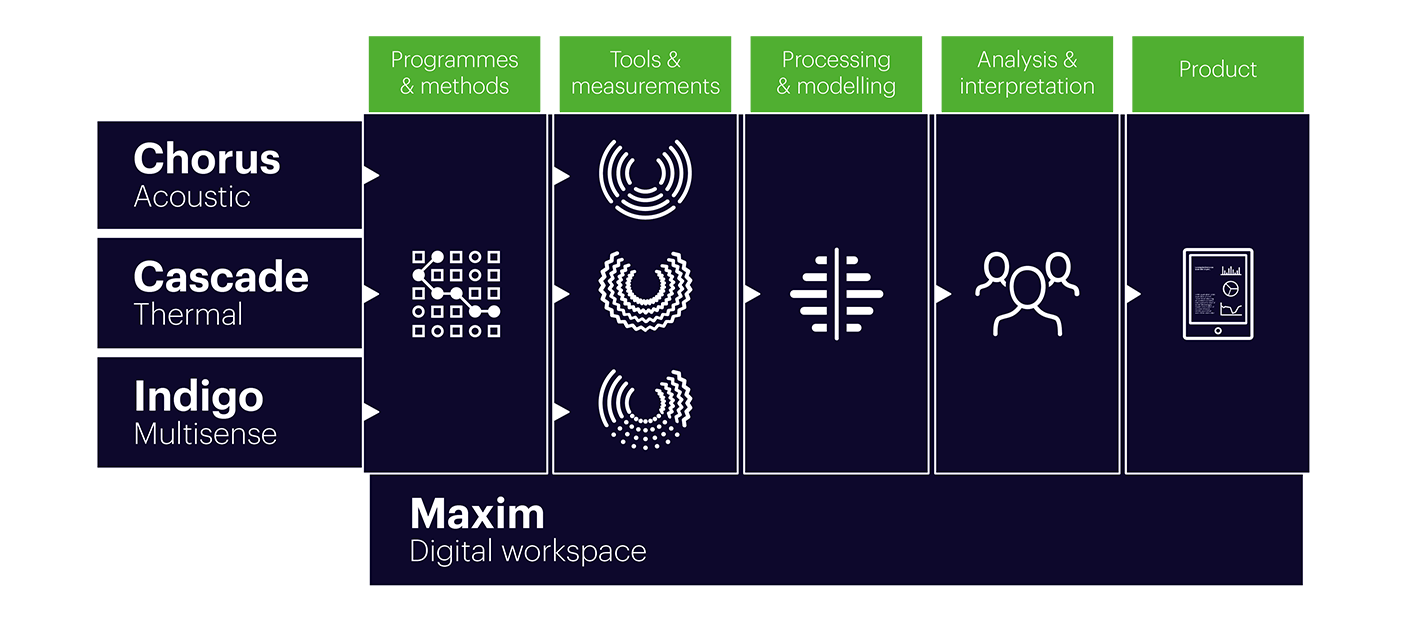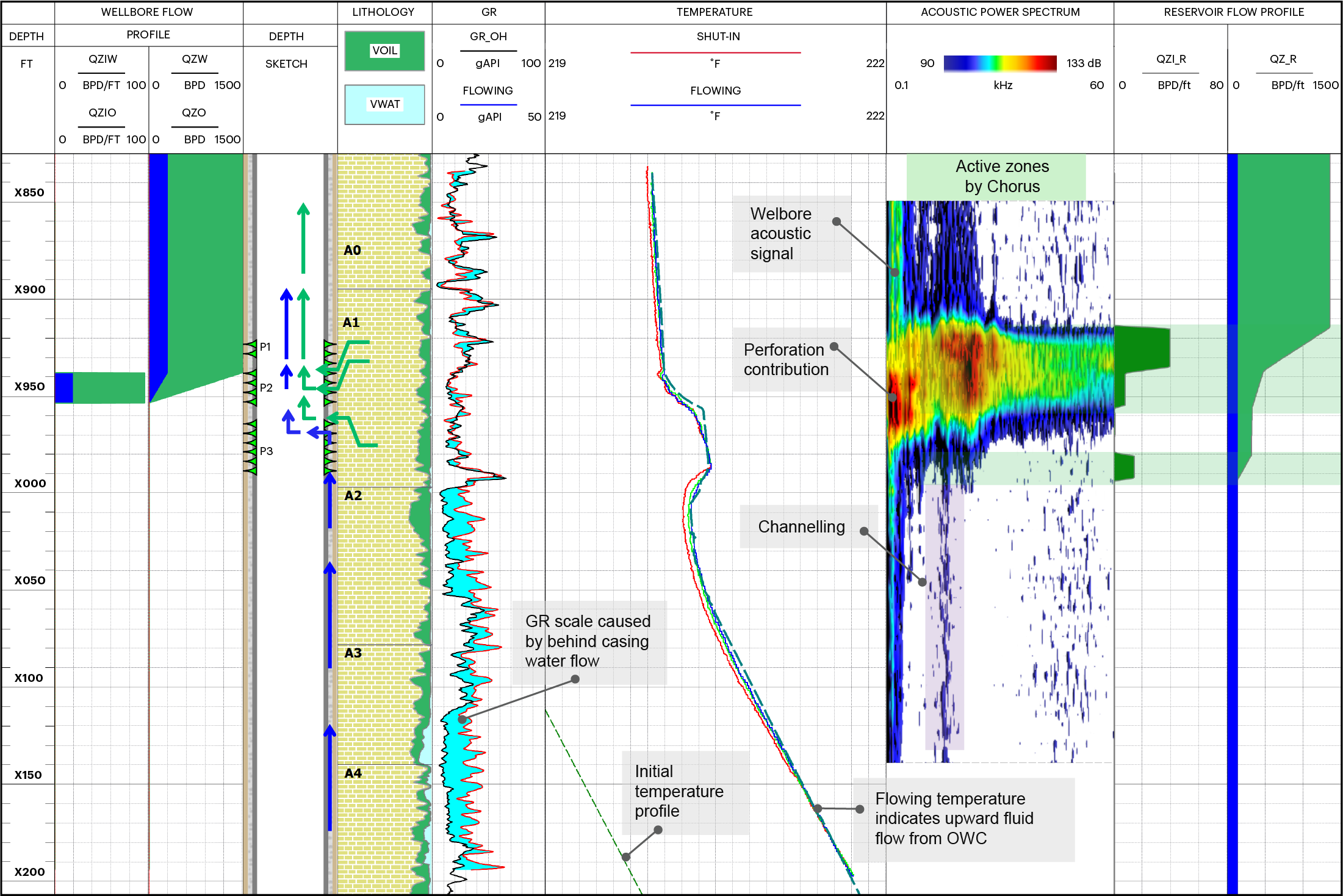Article featured in Harts E&P
The last few decades have brought impressive advances in ‘production logging’ technology, especially in the context of new sensor designs and diagnosing complex flow downhole. Fibre optics are also playing an increasing role in production surveillance. However, the fundamental technique of using wellbore-confined production logging tools (PLT’s) to infer total well and reservoir flow performance still dominates the industry.
Basically, PLT measurements are used to monitor fluid properties and flow dynamics in the wellbore and importantly, to determine production and injection ‘flow profiles’ where fluids enter or exit the wellbore, such as via perforations or inflow control devices. These measured and calculated flow profiles are used to assess the production and injection performance of the entire well system.
However, the validity and accuracy of this approach depends on many factors, and chief amongst them is the ‘integrity of communication’ between the wellbore and reservoir formations at the entry/exit points. Analysts and operators using PLT’s must assume that fluids entering or exiting the wellbore are flowing radially from or to the formations directly behind the entry/exit points. And unfortunately, this is often not the case. Flowpaths can exist through annular cement channels, formation packers or natural fissures, and fluid will always find the path of least resistance. From a compliance, environmental and performance perspective, these unwanted flowpaths are bad news. Decisions made assuming wellbore flow correlates directly to target reservoir flow can lead to complex reservoir and field management issues, and compromised asset performance. From a diagnostics perspective, it’s clear that analysts and operators can’t rely on PLT’s alone to diagnose and manage well system performance – a more powerful diagnostic approach is needed.
The challenge of behind-casing ‘cross-flow’ is not new and the industry has made several attempts over the decades to diagnose this insidious phenomenon. Some of the early techniques used nuclear activation, chemical tracers and noise logging to try to detect and map flow behind pipe, but these methods generally lacked the precision demanded of modern-day diagnostics and were, at best, qualitative. However, fueled by an increased operator focus on compliance, the need for better asset performance, and pure ingenuity, a new diagnostic capability has emerged that is rapidly becoming the new industry standard for diagnosing flow downhole.
Understanding the dynamics and connectivity of wellbore and reservoir flow downhole with any degree of precision and accuracy is a highly complex task that extends beyond the capabilities of conventional ‘logging’.
Which is why ‘True Flow diagnostics’ utilises a more powerful ‘system-based’ approach. The True Flow system combines experience and expertise with proprietary technology and an industry proven workflow to deliver a more complete picture of well system flow dynamics, and enable better informed well, reservoir and field management decisions (Figure 1).
The first ingredient and stage in the workflow is ‘Programmes & methods’. Following an initial customer consultation, analysis of well performance history, completion design, reservoir and fluid properties and assessment of diagnostic objectives, analysts customise a survey programme that will effectively ‘stress-test’ the well system to expose its flow dynamics in a number of scenarios. This can be likened to a heart specialist exercising a patient on different treadmill settings whilst scanning physiological parameters such as heart-rate, blood pressure and electro-cardio signals. Typical programmes will include a precisely-timed sequence of flowing and non-flowing surveys that allow the entire well system to warm-up and cool-down between surveys.
The second stage and ingredient is the application of high-fidelity ‘Tools & measurements’ by engineers that survey the well according to the diagnostic programme. The measurements come from basic and advanced PLT-type wellbore
probes, and a combination of proprietary acoustic and high-precision temperature sensors. Fluids flowing throughout the well system generate acoustic signals encoded with flow information. The acoustic sensing technology used by the True Flow system captures this information in the form of sound pressure across a wide frequency and amplitude range. Importantly, the remarkable dynamic range of this technology means it can sample absolute sound levels from deafeningly loud to imperceptibly quiet without losing clarity or detail. This means that a wide variety of flow scenarios can be located and characterised throughout the well system, from the wellbore to several metres into the reservoir formation. The temperature sensor in itself is unremarkable, being an industry standard fast-response, high-precision type capable of resolving to decimals of degrees. However, correlating temperature changes observed during the diagnostic programme and combining it with the acoustic data, wellbore flow measurements and other well and reservoir information is the key to quantifying flow by the next ingredient of the system – ‘Processing & modeling’.
During the processing and modeling stage, data acquired during the survey programme are enhanced further by analysts using a proprietary digital workspace and a number of processing and modeling ‘plug-ins’. High-resolution acoustic data are transformed into an ‘Acoustic Power Spectrum’ to reveal the characteristic signatures of different types of flow. Analysts can select from a catalogue of digitally enhanced spectra to illuminate particular aspects of the flow and extract maximum information from the acoustic signals.
The subsequent flow modeling is integral to the entire True Flow system and represents another significant advancement in flow diagnostics. Precision temperature measurements acquired during all stages of the diagnostic programme are assimilated together with all other data to derive ‘reservoir flow profiles’. These are distinct from conventional PLT-derived wellbore flow profiles because they quantify flow exiting or entering formation layers whether or not casing or perforations are present. Built on more than a decade of R&E and commercially proven in thousands of wells, the flow modeling engine solves complex thermohydrodynamic physics by matching simulated and measured temperature and other responses in the flow scenarios created during the diagnostic programme. The result is ‘quantified reservoir flow’ that together with wellbore flow measurements complete the total flow picture.
The previous True Flow stages are curated under the watchful eye of analysts who also administer the final important stage of the workflow – ‘Analysis & interpretation’. Armed with all available well data, processed and modeled results, and an expert knowledge of true flow applications, the analyst will derive and compile the diagnostic result. Whilst more complex scenarios can take a number of days to complete, the final result is a more comprehensive and accurate diagnostic of reservoir and wellbore flow that ultimately leads to better well management decisions and improved asset performance.
The True Flow system is used to provide a range of diagnostic answer products that address most flow-related applications. These products include ‘Total Flow’, which combines both wellbore and reservoir flow (Figure 2), ‘Sand Flow’ for sand management applications, ‘Fracture Flow’ to optimise fracturing programmes, ‘Stimulate Flow’, ‘Horizontal Flow’, and many more.
The old thinking cannot answer today’s new challenges. As well systems become more complex and older, managing performance will remain a priority and continue to task the industry. Wells are built to connect the right fluids to the right places, safely and productively, but forces, materials and age conspire to undermine this perfect balance. Traditional production logging will continue to play an important role in managing production, but it’s clear that we need to look beyond the wellbore, to the reservoir itself, in order to see the true picture.

